
Belgian Shepherd Rescue and Rehab. Australia
Belgian Shepherds are one of the most intelligent dogs you’ll find. Our old friends at Wikipedia had this to say about them.
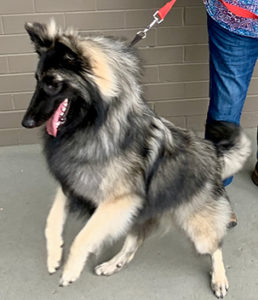
You can see why people love them ……. they truly are a magnificent animal.
Belgian Shepherd Dogs are described as highly intelligent, alert, and sensitive to everything going on around them, and form very strong relationship bonds. They are said to be loyal, intelligent, fun, highly trainable and well suited to family life. They should receive plenty of socialising as puppies and benefit from regular activity and close interaction with people throughout their lives. Their herding heritage gives them a comparatively high energy level, and mental as well as physical exercise is necessary to keep a Belgian happy and healthy. In 2012, the North Wales Police force harnessed a Belgian Shepherd herding behaviour, headbutting, in a novel approach to subduing criminals. The dogs are muzzled to prevent bites, and trained to forcefully headbutt targets at the midriff on command, knocking them off balance. Belgian Shepherds do well in sports such as obedience training and dog agility. They are used as assistance and search and rescue dogs, as well as police, military, and narcotics-seeking dogs
Not a bad CV for a job application in quite a few branches of the canine labour force, you’d have to say. And didn’t you just laugh out loud that the Rugby loving Welsh had taught them how to tackle? And they make great family dogs as well.
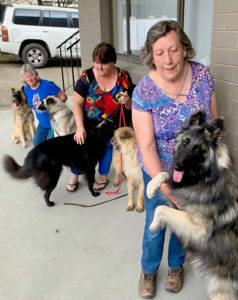
Sometimes it’s hard to get everyone looking at the camera at the same time …
LifeWise caught up with Jody Hafey, Co-ordinator of Belgian Shepherd Rescue, and breeders Bronwyn Durran and Lesley Longmuir at Bulla when they were there for the annual Belgian Shepherd Dog Club VIC, Breed Specialty Show. Needless to say, they’re devoted to the breed, but more than that, they’ve been involved in rehabilitating, retraining and rehoming shepherds for, collectively, nearly 15 years and have some down to earth viewpoints on steps that should be taken to make the experience of having a pet more enjoyable for both the animal and the owner.
Jody’s connection with dogs goes back to her childhood in Sydney. Her Mother bred Labradors; her Grandmother and Aunt bred Pomeranians. She grew up in a dog breeding home. “I was put in the ring with my first dog – apparently – when I was about three years old. Mum worked with the famous Jack Goldstein and it was through that connection that I learned my initial dog training skills”. When the kids left home she thought it was time to return to her early love. They’d always had Dalmatians, but when the last one died of a brain tumour they just couldn’t get another one. She wanted to breed and show, but when they looked at Great Danes, German Shepherds, Giant Schnauzers there were complications of co-ownership which meant you never really owned your breeding line outright. Then they looked at Belgian Shepherds, and that was it. Although, because of the limited supply, the wait for a puppy took some time. But in 2013 her chance came along, and she started showing Etta, her foundation bitch.
Naturally, she became involved in the activities of the Belgian Shepherd Club. They didn’t actually operate a traditional rescue as such, but if a rehoming request came in, they would advertise the availability of that particular dog for adoption through the normal channels.
“The work seemed to fall to me, mind you I was happy to oblige, and we found the more dogs we helped the more dogs came to us for help. Some of these dogs needed help with their wellbeing and this specialised workload built up, so in 2015 I took it on myself to do this as a rescue in its own right. Within the rescue world, there is a vast underground network built on trust; you get to know who you can trust and who you can’t trust, and it’s not easy to get into that network.
“The RSPCA recently, gave my number to someone wanting to surrender a German Shepherd in Queensland while I was down here at Bulla. Within 15 minutes and a couple of phone calls we had someone on their way to collect the dog. That’s the way it should work”.
However, we don’t live in a perfect world. Jody was measured in how she voiced her concerns but didn’t shy away from going on the record with them. “There’s rescue groups that we feel – although we can’t prove this – that are representing puppy farms. You can’t tell me that there are that many puppies on the market that need rescuing. They always have puppies and all different breeds. With prices like $1,000 – it just doesn’t smell right. If it waddles like a duck and quacks like a duck, it probably is a duck, right?”
Jody explained the fund-raising complexities of rescue groups from state to state. “They’ve all got different levels of compliance when you’re asking for funds to operate a dog rescue and it was a total nightmare making sure you were operating within the law. In one state you can ask for anything as long as it’s under a certain amount, in another you have to register with Office of Fair Trading to ask for anything, in another you need to register as a charity ……. Like I said, it’s complicated.
“Belgian Shepherd Rescue & Rehab Australia has been operating for approximately 5 years and over that time we have helped many dogs from all four variety of Belgians. Most common variety coming into or through rescue is the Malinois; the Tervuren is the second most common. There have been a few Groenendael and the least is the Laekanois – most likely because there are so few in the country.
“Belgian Shepherds are a rare breed and because of their nature, are closely held, but we also rescue German Shepherds, Irish Setters, French Bulldogs, to name a few of the breeds we take on when asked – if we have the capacity. Belgian Shepherd Rescue & Rehab is predominantly a pure-bred dog rescue; however we don’t limit ourselves to registered pedigree animals as long they at least look like the breed they are supposed to be. There are many organisations out there and we really have limited resources so we have to draw the line somewhere and concentrate on the breeds where we have specialists who can handle that particular breed.
“I hate to say it, but I’ve had to turn dogs away. On average, we’d get 5-7 German Shepherd enquiries a day across Australia, from people needing to rehome or surrender their dogs.
“We had a case recently; a woman inherited a German Shepherd that had been left behind by a flatmate. It had bitten a child and the child needed stitches. The woman wanted to surrender the animal to us and became upset when we said we couldn’t take it. I explained the three choices she had. One, phone the RSPCA; if they’ll take the dog, they’ll likely euthanise it. Two, phone the Council; if they’ll take the dog, they’ll likely euthanise it. Three, phone the Police and report the bite; they’ll take the dog and euthanise it. Now, guess what happened to that dog? Another rescue group took it and rehomed it. It bit somebody else and got euthanised. It seems to be an endless cycle”.
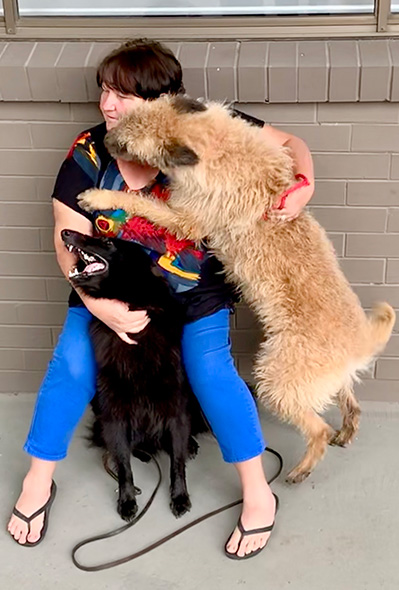
No one has ever said Belgian Shepherds weren’t lively and loving ……… Jody with Lucy the Groenendael and Arwen the Laekenois.
Jody’s childhood experience in dog training had, by later in life, become a passion. “In the old days training was all pretty rigid; all about instilling obedience in the animal. Then I became interested in the animal’s behaviour; how you got your pet to do, what you wanted it to do, because it wanted to do it too. When you start looking into animal behaviour, if you have an amazing bond with your animal, they want to please you; they want to do what you want them to do, because they want to do it. You do have naughty puppies and the process can test your patience at times.
“I’ve been learning about behaviour modification and I’ve been really lucky to have learnt from some of the world’s best. Dr. Kat Gregory, who’s in Melbourne; Peter Clarke’s another one; and Justin Palazzo-Orr, who actually got me into animal behaviour.
“A Belgian Shepherd puppy came to me at four months of age and you’d have to say she had every behavioural issue you could imagine. She was the classic problem dog so I went to some courses Justin was running. She is six now and totally manageable and socialised. It was needing to know how to modify her demeanour that started me on the behaviour journey”.
It wasn’t clear whether Jody’s next comment was a reflection of her wider acquaintance group, or her dogs. “Belgian Shepherds are smarter than most people I know. They’re not a dog you can dump in the backyard. Generally speaking, a Labrador you can run in the backyard and it’ll take care of itself. With a Belgian Shepherd, if you don’t find something for them to do, they’ll find something themselves. And they need to be part of the family; not stuck outside. They’re very loyal and very loving. I’d never have any other breed now”.
There are four categories of Belgian shepherds shown and there’s the usual debate about whether the four agreed styles are separate breeds or four varieties of the one breed. In part, this is what Wikipedia had to say on the matter.
The first breed standard was written in 1892, but official recognition did not happen until 1901, when the Royal Saint-Hubert Society Stud Book began registering Belgium Shepherd Dogs.
By 1910, fanciers managed to eliminate the most glaring faults and standardize type and temperament. Debate has continued about acceptable colours and coat types. Structure, temperament, and working ability have never been debated in regards to the standard.
In Belgium (the country of origin), all four types are considered to be varieties of a single breed, differentiated by hair colour and texture. In some non-FCI countries and other regions, they are considered separate breeds.
The Belgian Shepherd is a medium to large-sized dog. Breed standards expect specimens to be athletic and balanced in appearance. They have a squarish build.
The four varieties of Belgian Shepherd are distinguished by their coats and colours:
- The Groenendael (registered as Belgian Sheepdogs by the American Kennel Club) is fairly long-haired, having a double coat of coarse, long guard hairs over softer, shorter down hairs. The overall coat texture is stiff, tight, and thick, developed to withstand the elements. Colouration is generally solid black, though sometimes with small white markings on the chest and toes.
- The Laekenois has wiry, overall fawn-coloured hair, but with intermingled white hairs. It lacks the black mask and ears of the Malinois, which is often also a light brown; however, most breed standards permit some darker shading on the muzzle and tail.
- The Malinoisis short-haired, tan to brown (usually mahogany), with hairs agouti-ticked with black to varying degrees. It has a black mask and ears, and sometimes has white markings on the toes and chest.
- The Tervurenis found in the same colour range as the Malinois, but may lean toward grey or sable (not permitted in all standards), and has long hair, forming a double coat like that of the Groenendael. It also sometimes has white markings on the toes and chest.
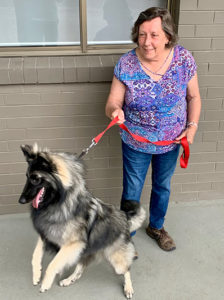
Lesley with her Tervuren Misty. She and Jody are two of only four registered breeders of Laekenois in Australia.
Jody said the best known variety, because of the 2015 film Max – was the Malinois. “In fact, our biggest problem is the working line Malinois. Because they’re bred for drive and focus, they generally aren’t suitable for family pets. Those who don’t become service dogs with professional handlers are sometimes, put out to tender. They’ve had training, sure, but not the training you or I would want for a domestic pet to run around the backyard and play with the kids. It becomes a problem for us as rescuers.
“There’d be around 20 breeders of Belgian Shepherds and around as many again who concentrate in breeding the highly specialised working-line Malinois, with all their high energy and high focus. When these dogs become part of an ordinary household it gets very frustrating. It hurts me to say this, but we have to say, I’m sorry, we can’t help you. You have to put that dog to sleep. We just have to be pragmatic. There are millions of dogs out there. We can try to find the right home for the dog, but we can’t save every life.
Jody has trouble with the misconceptions about dogs today. She comes from the old school where a dog was man’s best friend but was still a dog. “It’s almost become trendy to have an anxious dog – my dog’s anxious, isn’t yours? From a rescue perspective it drives me crazy. Mollycoddling’s maybe not the right word, but we’re not allowing dogs to be dogs anymore. They’re either ignored, or being treated as though they’ve got all these disorders. We’re putting labels on everything. They’ve got fear anxiety, or they’ve got fear aggression; and it does my head in because dogs don’t think the way we think. They don’t think, Oh, I’m going to walk through the door before you do because it makes me higher in the pecking order. They just see the opening and walk through it. If the dog jumps from a loud noise, that’s okay; so do we. It doesn’t mean it’s an anxious dog. It just means it jumped from a loud noise. It shows they’re alert.
“I’m not into punishment based training methods, I prefer and train with reward based methods. The dogs learn more and they want to work for you and with you, it builds a much stronger relationship with your dog. You catch more flies with honey than vinegar.”
Some of Jody’s stories would be funny if the outcomes hadn’t been so sad. There was the case of the German Shepherd Husky cross. “The owner bought it off Gumtree as a 5-week-old puppy. It had the run of the house and the yard but that was it. It’s nearly one by the time I get the call and it’s had basically no training or socialisation whatsoever”.
“It’s a dog like Max in the movie, it’ll train itself, right?”
“Wrong. I got the call after it had bitten the 7-year-old son of the house. Getting the full story was like drawing teeth. What were the antecedents to the incident?”
“Oh, the dog was stressed …….”
“No, not what the dog was thinking, what actually happened?”
“It was anxious ……”
“She kept wanting to put human emotions on the animal. It finally came out; the kid had moved the dog’s bowl while it was eating. I told her to feed the dog outside and leave it to eat in peace”.
“But it’s part of the family ……”
“That was the first bite. A couple of weeks later I get a call. The dog had bitten the kid again as well one of his friends. I told her it was a dangerous situation and that having the dog put to sleep was the most likely option. She contacted an internet group who explained she would have to make the dog learn its place in the pack. You need to be pack-leader. Get the children to prepare the dog’s meal and feed the animal to establish dominance. She sends me a video of the child sitting on the floor paddling in the dog’s bowl while the dog is circling in frustration. You shudder when you think about it, don’t you?
“The next time she’s on the phone she’s in tears. The dog’s mauled the 7-year old. There’s blood everywhere. Hubby’s yelling and the kid’s screaming. It turns out the kid had taken his role as the dominator too seriously and “Max” had had a gutful. Hubby had rushed the child to the hospital and she asked if she could bring the dog to me to deal with. I said yes, in the meantime I rang my vet and made an appointment. To cap it all off, I got bitten myself getting the poor animal to the vets to be euthanised.
“I should never have had to do that. And none of this would ever have happened if she’d done what I told her to do in the first place. But it’s what we face every day, and just because people either have dogs they shouldn’t have, or dogs are owned by people who don’t understand them. They get the cute puppy, plonk it in the backyard and expect it to grow into “Max” the security dog. They do nothing with the dog and wonder why it’s uncontrollable. It’s what we’re dealing with every day in the rescue world”.
As breeders, Jody and her colleagues had a problem with the irresponsible commercial production of dogs. One of the tasks we’ve set ourselves is to get governments to look seriously at what’s going on and take practical steps to deal with the situation”.
Jody related some of the horror rescues they’d undertaken and the uncontrolled churn out from what are more puppy factories than puppy farms, with all the connotations the name implies. “Some of the crosses we come across are ludicrous, other combinations are downright dangerous. It really becomes a lucky dip. When you’re breeding to a breed standard, you’re building on traceable generations of selection that have been targeted to produce an inherently healthy animal with standardised configuration and temperament; a selection program that has eliminated, as far as possible, unwanted traits, both in health and temperament.
“When you start crossing breeds to get a “new” dog, you run the risk of bringing those unwanted traits back into the gene pool. When this is being done by unscrupulous people whose only interest is the dollars, it creates a flood of dogs that have lost all those generations of selective breeding; breeding that made them what they were in the first place. Down the track, it’s the rescuers who have to clean up the mess, and when you think about it, it’s not good for the dog’s quality of life either.
“Some states are getting the message – Victoria has a sort code system that allows traceability – but in Queensland you can just go on-line and register to get a Breeder’s Identification Number (BIN). No one checks up on the applicant and the public think that it carries some sort of integrity guarantee. It doesn’t; I could get you one today if you wanted one. This is the sort of lack of understanding of the issues involved that we’re trying to get the authorities to recognise, and act on.”
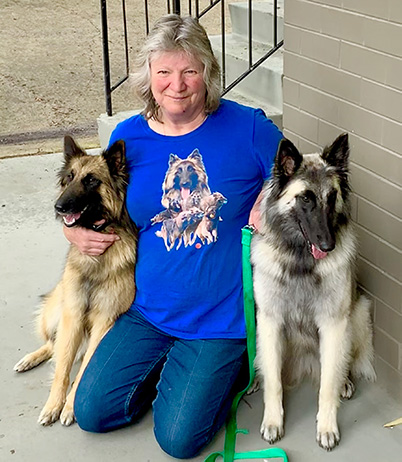
Bronwyn with her Tervurens Roxie (L) and Asher (R).
Jody, Bronwyn and Lesley were all strong on breeding for the betterment of the breed standard and also questioned the feeding practices they came across. Jody told of one owner who fed a raw diet but gave her dog kibble three or four times a week to make sure it was getting the right nutrient balance. “She had it totally the wrong way around. To start with, to get the right nutrient balance by feeding raw food you’d need a science degree. We’ve been on LifeWise for 12 months now and one thing I’ll say is that the dogs have never looked better. More than that though; we had one dog on medication to stabilise it enough to be able to work with it. The animal still has a few behavioural issues but since being on LifeWise it’s off the meds and is a much happier, calmer dog.”
“Another sign that the balance is right is the response from the rescue dogs that come in. We never know what they’ve been fed and a change of diet will usually cause the runs anyway, but with LifeWise the stools firm up straight away. As their nutritionist Bill Wiadrowski said, if you can get your dogs 100% on the inside they’ll be 100% on the outside. You can see the difference in the dogs’ coats and there’s a physical and temperament change. You could put your makeup on from the natural sheen in their coats. We hardly have to bath them now. We’re feeding less and they crap less. We wouldn’t feed anything else now”.
As we left Jody was taking a call. “No, tell me exactly how it happened that the dog had been chained on its own for a month ………”
Belgian Shepherd Rescue & Rehab. Australia – check out their Facebook page
Jody can be contacted on 0419 114 394
Bronwyn can be contacted on 0417 585 315
Lesley can be contacted 0425 743 608
